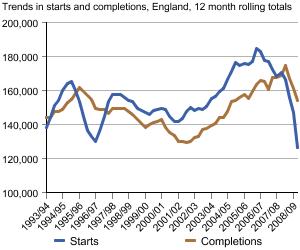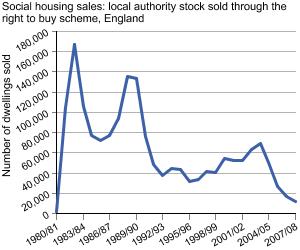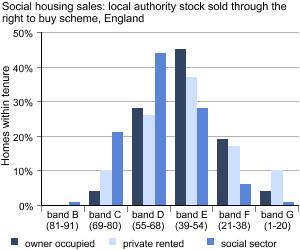Housing stock covers statistics on new house building activity, changes in the number of dwellings and the supply of affordable housing as well as statistics on the condition of the housing stock.
Publications
This Statistical Bulletin presents further data on affordable housing in Wales.
Starts and completions of affordable housing for England, bringing together those funded by the HCA and those funded by the GLA

This release presents data on affordable housing supply in England. This was previously entitled 'Gross Affordable Housing Supply’ and has been renamed to 'Affordable Housing Supply’. This is following an assessment recommendation by the UK Statistics Authority in order to align the naming conventions used across the Publication Hub and the DCLG website. This should help users to find comparable releases over time. The scope and definitions of the statistics have not been changed.
A survey of the design quality, as measured by CABE Building For Life criteria, of affordable housing in England, commissioned by the Homes and Communities Agency.
This Statistical Release presents data on affordable housing in Wales.
Statistics on the number of dwellings that have been certified to the standards set out in the Code Technical Guide, in which local authority area, at which Code level and whether the homes are registered as private or public sector homes. This will also include the average SAP (Standard Assessment Procedure) energy efficiency rating of newly constructed dwellings in England and Wales, and the averages for each region and each dwelling type.
Statistics on the number of dwellings that have been certified to the standards set out in the Code Technical Guide, in which local authority area, at which Code level and whether the homes are registered as private or public sector. Statistics on Energy Performance Certificates are based on SAP (Standard Assessment Procedure) energy efficiency ratings of dwellings in England and Wales, with breakdown by region and dwelling type.
This Statistical Release presents data on total dwelling stock estimates by type of tenure and local authority.
Gives the number of homes in England, down to district level, and draws on a range of sources to compile the tenure profile of the stock.
Headline findings about living conditions.

The survey collects information about people's housing circumstances and the condition and energy efficiency of housing in England.

This release presents data on affordable housing supply in England. This was previously entitled 'Gross Affordable Housing Supply’ and has been renamed to 'Affordable Housing Supply’. This is following an assessment recommendation by the UK Statistics Authority in order to align the naming conventions used across the Publication Hub and the DCLG website. This should help users to find comparable releases over time. The scope and definitions of the statistics have not been changed.
Starts and completions of affordable housing under HCA schemes (excluding London)
Starts and completions of affordable housing under HCA schemes.

House building starts and completions statistics by tenure .

Presents data on dwellings demolished and hazards found.

This Statstical Release presents information on dwelling demolihed or closed in Wales

This Statistical Release has now been replaced by two separate releases titled 'Social Housing Stock, Lettings and Vacancies' and 'Social Housing Rents and Rent Arrears'.

Routine update of housing statistics web tables plus summary of key trends

Routine update of housing statistics web tables and summary of key trends.

Presents the results from the Survey of English Housing.
Information on the housing stock in England.

Compendium of housing and planning statistics covering most aspects of housing and planning in England

Housing data on tenure, owner occupation and the social rented sector; principle source of information about the private sector.
Social Housing Statistics

Statistics on local authority-owned stock and stock management, including housing stock, households on local authority waiting lists, participation in Choice-Based Lettings, local authority lettings, Decent Homes delivery, programme of work on HRA stock, possessions and evictions, anti-social behaviour and injunctions. This replaces the Local Authority Housing Statistics: Housing Strategy Statistical Appendix (HSSA) and Business Plan Statistical Appendix (BPSA).
Provisional estimates of the percentage of non-decent local authority homes ahead of final estimates in the full Business Plan Statistical Appendix (BPSA) 2009-10 statistical release.
Net additional dwellings.
Net additional dwellings.

This Statistical Release present information on new house building for all tenures and sales of social housing in Wales.

This Statistical Release presents data on houses built by all tenures.

Provides statistics on the number of new dwellings started and completed in Wales.

Statistics on housing compiled by Department for Social Development Housing Division and Northern Ireland Housing Executive.
Information on new house sales and prices, actions for mortgage possessions, and new housing starts.
The 2010 Private Landlord Survey is a national survey of landlords and managing agents who own and/or manage privately rented properties in England. The aim of the survey is to provide a snap-shot of the composition and experience of landlords and how they (together with any agent) acquire, let, manage and maintain privately rented accommodation.

Provides statistics on Private Sector Renewal Activity funded by local authorities in Wales.
Total Right to Buy sales by quarter

Provides statistics on the number of statutory sales of Registered Social Landlord (RSL) dwellings completed in Wales.

Presents summary stock holding figures for all Registered Social Landlords (RSLs) in Wales.

Presents information on the average weekly rents for wholly rented local authority and Registered Social Landlord (RSL) dwellings.

This survey looks at the physical condition of Scotland's homes as well as the experiences of householders.

This Statistical Release show data on social housing rents and rent arrears for Wales.
Total social housing sales in England, including Right to Buy, Right to Acquire & Social HomeBuy.

This Statistical Release presents data on social housing stock and rents.

This Statistical Release show data on social housing stock, lettings and vacancies in Wales.

This Statistical Release presents data on social housing.

This statistical release presents data on the number of dwellings that have been certified to the standards set out in the Code Technical Guide.

Data on vacant Local Authority dwellings.

Data on vacant dwellings.
This Statistical Release presents data on the percentage of social housing meeting the WHQS.
Overview
House building statistics show the number of new build starts and completions by tenure.
Dwelling stock statistics show the number of dwellings as at 1 April each year by tenure.
Affordable housing supply statistics show the gross number of affordable homes supplied each year via Registered Social Landlords (RSLs), local authorities and private developers. The statistics give separate totals for social rent, intermediate rent and low cost home ownership dwellings. Statistics are also presented on losses to social housing stock through right to buy, preserved right to buy and right to acquire sales.
Net supply of housing statistics show the flows of dwellings during the financial year broken down by new build homes, changes of use, conversions and demolitions.
The English House Condition Survey (EHCS) is a national random sample survey of housing in England. It covers all tenures and provides a profile of the housing stock, its condition and energy performance, the people living there, and their views on housing and their neighbourhoods. It was run every five years from 1971 to 2001 and has reported annually since 2003 following its reorganisation to carry out data collection on a continuous basis.
Technical Data
House building statistics come from two sources on building control:
-
around half of the new build activity is recorded through quarterly house building returns submitted to Communities and Local Government by local authority building control departments, and
-
quarterly information from the National House-Building Council (NHBC) on the volume of building control inspections they undertake in each local authority
Dwelling stock figures are ‘census based’ for those years in which a census was undertaken. In-between census years, the total stock figures are obtained by adding the net supply of housing during the year to the stock at the end of the previous year. Local authority stock is submitted to Communities and Local Government by local authorities on the Housing Strategy Statistical Appendix.
Data on Registered Social Landlord (RSL) stock come from the Regulatory Statistical Return submitted to the Housing Corporation by RSLs. Private rented and owner occupied stock are estimated using the proportion of households reported in each tenure group on the Labour Force Survey (LFS).
There are several data sources on the gross supply of affordable housing, namely:
-
Investment Management System (IMS) figures from the Housing Corporation
-
the Housing Corporation Regulatory and Statistical Return completed by Registered Social Landlords (RSLs)
-
COntinuous REcording (CORE) jointly funded by the Housing Corporation and Communities and Local Government and completed by housing associations and local authorities
-
the Housing Strategy Statistical Appendix (HSSA) submitted to Communities and Local Government by local authorities
-
the P2 quarterly house building return submitted to Communities and Local Government by local authorities
-
Private Finance Initiative Scheme figures
Data on affordable housing sales are submitted to Communities and Local Government by local authorities on the P1B form and by RSLs to the Housing Corporation on the Regulatory Statistical Return and the CORE form.
Data on net housing supply are collected on joint regional assembly and Communities and Local Government returns in six of the nine Government Office Regions (GORs). In the other three regions, the data are collected on the Housing Flows Reconciliation Form submitted by local authorities to Communities and Local Government.
The English House Condition Survey (EHCS) has an achieved sample of approximately 8,000 cases each year, with reporting based on two-year and overlapping samples (that is, ‘2006’ findings are based on fieldwork carried out from April 2005 to March 2007, and ‘2007’ findings are based on April 2006 to March 2008 fieldwork).
It involves a physical inspection of property by professional surveyors (on which key condition and energy performance measures of the stock are based), a household interview and a market valuation of the property. It provides a wide range of statistics on the condition and energy performance of the housing stock including decent homes and energy efficiency.
Glossary
-
Affordable housing
Affordable housing includes social rented and intermediate housing, provided to specified eligible households whose needs are not met by the market. Affordable housing shouldmeet the needs of eligible households including availability at a cost low enough for them to afford, determined with regard to local incomes and local house prices; and include provisions for the home to be retained for future eligible households; or if these restrictions are lifted, for any subsidy to be recycled for alternative affordable housing provision.
-
Decent homes
The definition of a decent home is one that meets all of the following criteria: statutory minimum standard for housing; is in a reasonable state of repair; has reasonably modern facilities and services; provides a reasonable degree of thermal comfort. See ‘A Decent Home: Definition and guidance for implementation’, Communities and Local Government, June 2006.
-
Dwelling
In recent years (since 2001) a dwelling is defined (in line with the 2001 Census definition) as a self-contained unit of accommodation. Self-containment is where all the rooms (including kitchen, bathroom and toilet) in a household’s accommodation are behind a single door which only that household can use. Non-self contained household spaces at the same address should be counted together as a single dwelling. Therefore a dwelling can consist of one self-contained household space or two or more non-self-contained household spaces at the same address. More details on the definition of a dwelling and other housing terms can be found on the Communities and Local Government website.
-
Energy efficiency
A rating based on energy costs/m2 of floor area for space and water heating, ventilation and lighting, assuming standard occupancy of a dwelling. The rating is expressed on a scale of 1-100 where 1 represents poor energy efficiency (high costs) and 100 represents zero net energy cost per year.
-
Gross affordable supply
New affordable housing units (or bed spaces) provided to specified eligible households whose needs are not met by the market. Gross supply of affordable homes includes new build and acquisitions but does not take account of losses to the affordable housing stock through demolitions and sales.
-
House building
House building statistics collect data on permanent dwellings only that is, dwellings that have a design life of over 60 years. Data are collected on the number of homes started and completed each period.
-
House building completion
In principle, a dwelling is regarded as completed when it becomes ready for occupation or when a completion certificate is issued, whether it is in fact occupied or not. In practice, there are instances where the timing could be delayed and some completions are missed, for example, as no completion certificate was requested by the owner.
-
House building start
A house or flat is counted as started on the date work begins on the laying of the foundation but not including site preparation. It is sometimes difficult for data providers to identify whether a dwelling is being built for a Registered Social Landlord (RSL) or for a private developer. This may lead to an understatement of RSL starts and completions recorded in these tables, and a corresponding overstatement of private enterprise figures. The problem is more likely to occur with starts than completions.
-
Intermediate affordable housing
Intermediate affordable housing is housing at prices and rents above those of social rent but below market price or rents, and which meet the criteria set out above. These can include shared equity (eg HomeBuy) and other low cost homes for sales, and intermediate rent.
-
Net housing supply
Housing supply is measured in net additional dwellings, which measures the absolute change in the stock between 1 April and 31 March in the following year, taking into account new build dwellings and gains and losses through change of use, conversions and demolitions.
-
Right to acquire sales
The Right to Acquire scheme was introduced in April 1997 for tenants of Registered Social Landlord homes built after that date, with government grant. The Right to Acquire is a scheme giving eligible tenants of registered social landlords the legal right to buy the home they currently rent.
-
Right to buy sales
The Right to Buy scheme was introduced under the 1980 Housing Act with effect from October 1980, and gives eligible council tenants the right to buy their property from their council at a discount.
-
Social housing
Social rented housing is rented housing owned and managed by local authorities and RSLs, for which guideline target rents are determined through the national rent regime. It may also include rented housing owned or managed by other persons and provided under equivalent rental arrangements to the above, as agreed with the local authority or with the Housing Corporation as a condition of grant.
-
Tenure
There are up to four tenure categories for dwelling stock, house building and household figures. These are (1) owner-occupied (or private enterprise in the case of house building statistics). This includes accommodation that is owned outright or is being bought with a mortgage; (2) rented privately, defined as all non-owner-occupied property other than that rented from local authorities and RSLs plus that rented from private or public bodies by virtue of employment; (3) rented from Registered Social Landlords (RSL shared ownership and shared equity dwellings are included as owner-occupied in the dwellings in the house building statistics; and (4) rented from Local Authorities.
Contact Details
For statistical enquiries about this topic, please contact:
Communities and Local Government
Email: Housing.statistics@communities.gsi.gov.uk
Telephone: +44 (0) 303 44 42345
Communities and Local Government Floor 1/J1 Eland House Bressenden Place Victoria London SW1E 5DU



